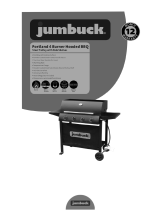
54
FOR YOUR SAFETY
Failure to comply with these instructions could
result in a fire or explosion which could cause
serious bodily injury, death or property damage.
CAUTION: Accessible parts may be very
hot.
Keep young children away.
DO NOT modify this appliance.
DO NOT move this barbecue during use.
Turn off gas supply at the gas cylinder after use.
Parts sealed by the manufacturer or their agent
must not be manipulated by the user. This barbecue
is only to be used and stored outdoors.
• Never operate this barbecue without a regulator.
• Do not test for gas leaks with an open flame.
• If this information is not followed exactly a fire
causing death or serious injury may occur. Do not
store a spare gas cylinder under or near this
barbecue. This barbecue is only to be used and
stored outdoors.
• If there is a leak on your appliance (smell of
gas) immediately attempt to turn off the cylinder
valve. Remove the appliance to a well ventilated
location away from any ignition source. Only
check for leaks outdoors using soapy water. DO
NOT try to detect leaks using a flame.
• Check for leaks by brushing a soap and water
solution over all connections. If you are unable to
correct the leak by tightening the connections,
turn off the gas and contact customer service
immediately.
• Only use the hose assembly as supplied with
this appliance for connection to the cylinder -
DO NOT USE ADAPTERS.
• Maximum hose length - 600mm.
• After use turn the gas cylinder valve off, wait
for the flame to go out, then turn the
appliance control valve off.
• Avoid twisting or kinking the flexible hose.
• Do not store or use petrol or other flammable
liquids in the vicinity of this or any other
appliance.
• Do not store empty or full spare gas cylinders
under or near this or any other appliance.
• Never test for gas leaks with a lit match or open
flame. Never light barbecue with hood closed or
before checking to ensure the burner tubes are
fully seated over gas valve orifices.
GENERAL INFORMATION
• Never lean over cooking surface when lighting.
• Never alter or modify the regulator or gas supply
assembly.
• This barbecue must not be used indoors.
• Only use in well ventilated areas.
• CARBON MONOXIDE HAZARD - USING THIS
APPLIANCE IN AN ENCLOSED SPACE MAY
CAUSE DEATH. DO NOT USE IN CARAVANS,
TENTS, MARINE CRAFT, CARS, MOBILE
HOMES OR SIMILAR LOCATIONS.
• This appliance shall only be used in an above
ground open-air situation with natural ventilation,
without stagnant areas, where gas leakage and
products of combustion are rapidly dispersed by
wind and natural convection.
• Ensure the barbecue is set up on a level and
stable surface.
• Do not move the barbecue while in use or when
hot. Remove the drip tray before moving.
• DO NOT replace the grill with an extra hotplate.
The warranty will be voided and it violates the gas
approval, the grill provides the ventilation needed
for the BBQ to operate safely. It is not designed
to be a solid hotplate device.
• Do not spray aerosols in the vicinity of this
appliance while it is in operation.
• Do not place or lean articles on or against this
appliance.
IF THERE IS A LEAK
• Turn the cylinder off.
• Ventilate the area to disperse gas.
• Check all connections.
• If leak persists, keep the cylinder upright. Keep
skin away from any gas or liquid escaping from
the cylinder.
• Keep the cylinder at least 20 metres away from
any sparks or ignition sources, including electrical
equipment, camera flashes, engines and motors.
• Disperse gas by encouraging maximum
ventilation and spraying with a fine water spray.
IF THERE IS A FIRE
• If the fire is at the barbecue, turn the gas off at
the cylinder. Smother the flames with a wet cloth,
fire blanket or extinguish using a fire extinguisher.
• If the fire is at the cylinder, or you can not get
to the valve to turn the gas off, contact the fire
brigade immediately.
• Using a garden hose, direct the water to the
middle of the cylinder to keep it cool. Try not to
extinguish the flame. At least if the gas is burning,
it won’t be able to build up pressure and explode.

























